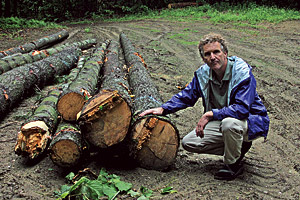 |
||
| uvm a - z | directory | search |
 |
DEPARTMENTS LINKS
|
Toward Greener Forests
David Brynn '76 G'91

photo by Cheryl
Dorschner
When
you first meet forester David Brynn ’76 G’91 you’re more
likely to think of Paul Newman than Paul Bunyan. Tall, gray at the temples,
and easy to smile, Brynn has an affable grace that would serve him on
a movie set — but he has more important work to do in the forests
of Vermont.
“Forestry
is not just timber management,” he says, standing in the rain at
the University of Vermont’s research forest in Jericho. Here, on
500 acres, Brynn has begun his new work as director of the Green Forestry
Education Initiative, part of an effort by the Rubenstein School of Environment
and Natural Resources to re-imagine — even revolutionize — the
purpose of forestry education.
“Forestry should be a cycle that returns health to forests and value
to their stewards,” he says. Then he points to an unassuming cinderblock
shed. “That building, and this forest, will be a seedbed for teaching
this idea.”
Brynn’s
own education as a gentle revolutionary came from the woodlots and skidyards
of Vermont. Since 1976, when he completed his UVM degree in forest management,
Brynn has worked for the state as a forester, including his most recent
post as the Addison County forester.
“I
had the best job in the state,” he says, stepping inside his new
classroom, “but I saw the hard realities of Vermont’s forest
industry.” Brynn looks across the battered hardwood floor toward
the white pines beyond and begins to describe what he saw: forests “high
graded,” all their most vigorous trees cut; small-scale private landowners
— who own 63% of Vermont forests — receiving stumpage checks
that didn’t meet their tax bill; mills and out-of-state buyers capturing
most of the profit-per-tree in finished products; state education efforts
focused on improving timber quality, but little investment in programs
to help stewards succeed in the marketplace.
So he
decided to do something to help. In 1995, he founded Vermont Family Forests,
a nonprofit organization that today is brimming with programs dedicated
to conserving forest health, including affordable “green certification”
to help small landowners get a higher price for logs harvested in an ecologically
sound way; a “community forest” in Monkton where VFF and the
Vermont Land Trust hold the development rights allowing lower-income investors
to own a share of a forest, whether for firewood or camping; and a Family
Forest brand that can boost the bottom line for families by collectively
marketing premium products like flooring and maple syrup.
Now Brynn
is bringing the lesson of his experiences — that a healthy forest
and a healthy forest economy depend on each other — to a new generation
of foresters.
“UVM
is extraordinarily lucky,” says Brynn’s friend, the writer Bill
McKibben. “It’s as if years ago they had hired Bob Rodale to
start a program on organic farming. David Brynn is the most innovative
forester in America.”
—Joshua Brown
